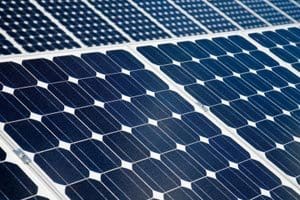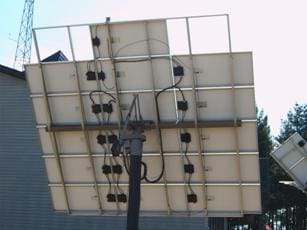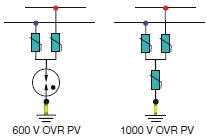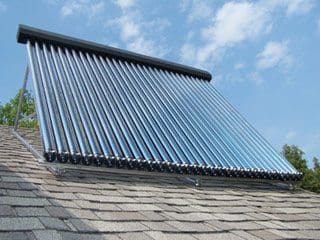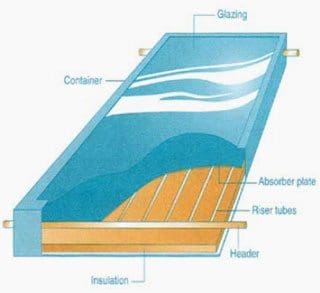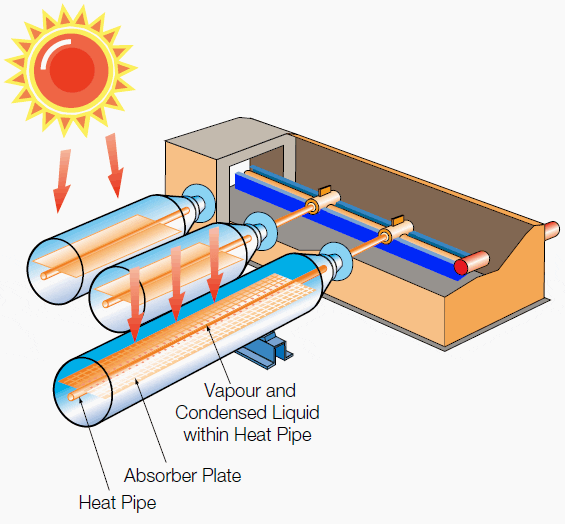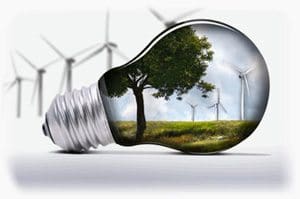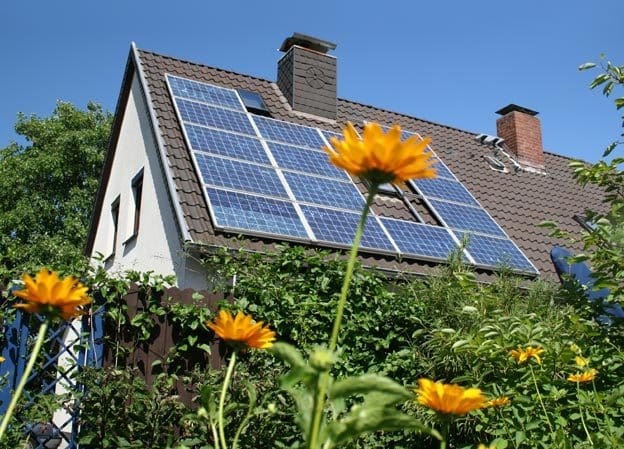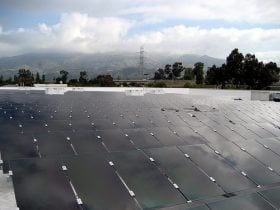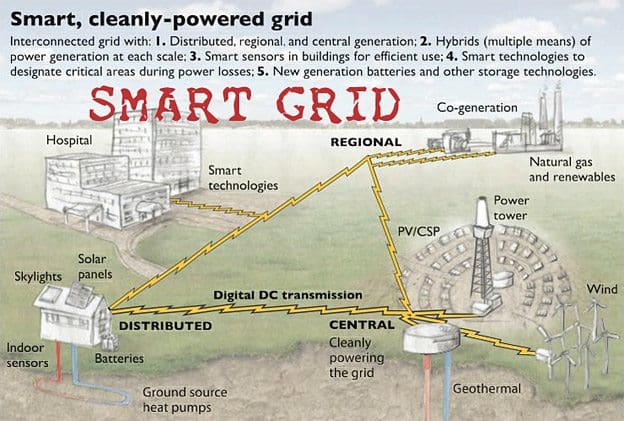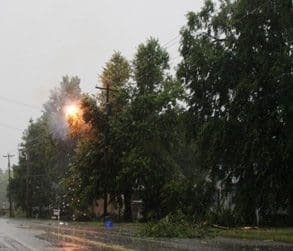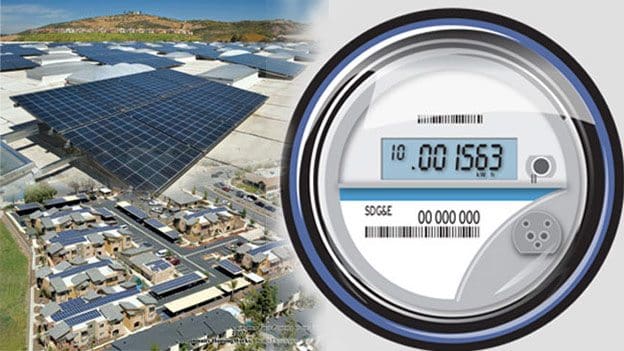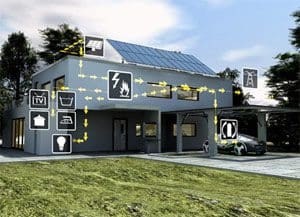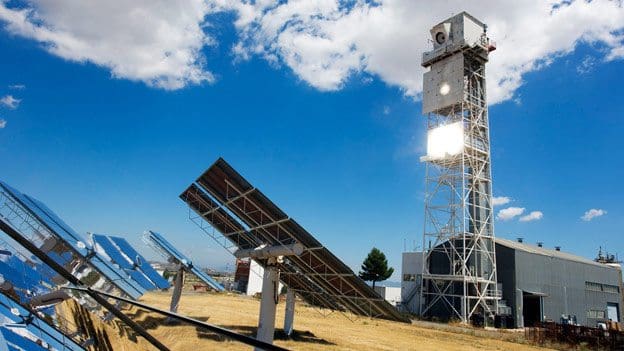 |
| Solar tower - Power plant. In solar power stations, mirrors are used to concentrate sunlight and convert it into thermal energy). This process enables temperatures of more than 1000 degrees Celsius to be achieved, which can be used to generate electricity, among other things. |
Solar power towers generate electric power from sunlight by focusing concentrated
solar radiation on a tower mounted heat exchanger (receiver). The system
uses hundreds to thousands of sun-tracking mirrors called heliostats to
reflect the incident sunlight onto the receiver. These plants are best
suited for utility-scale applications in the 30 to 400 MWe range. In a
molten-salt solar power tower, liquid salt at 290ºC (554ºF) is pumped
from a ‘cold’ storage tank through the receiver where it is heated to
565ºC (1,049ºF) and then on to a ‘hot’ tank for storage.
When power is needed from the plant, hot salt is pumped to a steam generating system that produces superheated steam for a conventional Rankinecycle
turbine/generator system. From the steam generator, the salt is returned
to the cold tank where it is stored and eventually reheated in the
receiver.
Figure 1 is a schematic diagram of the primary flow paths in a molten-salt solar power plant.
Determining the optimum storage size to meet power-dispatch requirements is an important part of the system
design process. Storage tanks can be designed with sufficient capacity
to power a turbine at full output for up to 13 hours.
Solar tower configuration
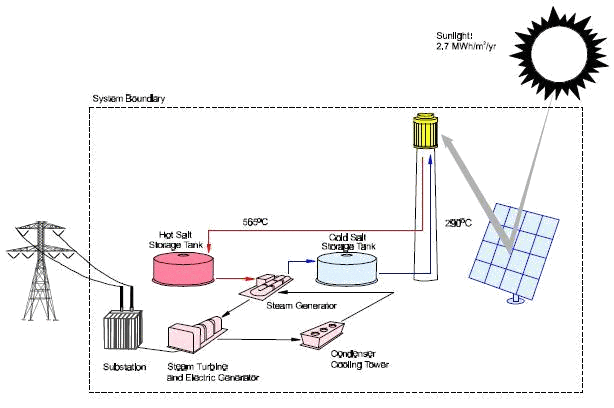 |
| Figure 1. Molten-salt power tower system schematic (Solar Two, baseline configuration). |
The
heliostat field that surrounds the tower is laid out to optimize the
annual performance of the plant. The field and the receiver are also
sized depending on the needs of the utility. In a typical installation,
solar energy collection occurs at a rate that exceeds the maximum
required to provide steam to the turbine.
Consequently,
the thermal storage system can be charged at the same time that the
plant is producing power at full capacity. The ratio of the thermal
power provided by the collector system (the heliostat field and
receiver) to the peak thermal power required by the turbine generator is
called the solar multiple.
With a solar multiple of
approximately 2.7, a molten-salt power tower located in the California
Mojave desert can be designed for an annual capacity factor of about
65%. (Based on simulations at Sandia National Laboratories with the
SOLERGY [1] computer code.) Consequently, a power tower could
potentially operate for 65% of the year without the need for a back-up
fuel source. Without energy storage, solar technologies are limited to
annual capacity factors near 25%.
The dispatchability of
electricity from a molten-salt power tower is illustrated in Figure 2,
which shows the loaddispatching capability for a typical day in Southern
California. The figure shows solar intensity, energy stored in the hot
tank, and electric power output as functions of time of day. In this
example, the solar plant begins collecting thermal energy soon after
sunrise and stores it in the hot tank, accumulating energy in the tank
throughout the day. In response to a peak-load demand on the grid, the
turbine is brought on line at 1:00 PM and continues to generate power
until 11 PM.
 |
| Figure 2. Dispatchability of molten-salt power towers |
Because
of the storage, power output from the turbine generator remains
constant through fluctuations in solar intensity and until all of the
energy stored in the hot tank is depleted. Energy storage and
dispatchability are very important for the success of solar power tower
technology, and molten salt is believed to be the key to cost effective
energy storage.
Power towers must be large to be economical. Power
tower plants are not modular and can not be built in the smaller sizes
of dish/Stirling or trough-electric plants and be economically
competitive, but they do use a conventional power block and can easily
dispatch power when storage is available.
In
the United States, the Southwest is ideal for power towers because of
its abundant high levels of insolation and relatively low land costs.
Similar locations in northern Africa, Mexico, South America, the Middle
East, and India are also well-suited for power towers.
System Benefits -Energy Storage
The availability of an inexpensive and efficient energy storage system may give power towers a competitive advantage.
Table 2
provides a comparison of the predicted cost, performance, and lifetime
of solar-energy storage technologies for hypothetical 200 MW plants
[5,6].
| Installed cost of energy storage for a 200 MW plant ($/kWhre) |
Lifetime of storage system
(years) | Round-trip storage efficiency (%) | Maximum operating temperature (C/ºF) | |
| Molten-Salt Power Tower | 30 | 30 | 99 | 567/1,053 |
| Synthetic-Oil Parabolic Trough | 200 | 30 | 95 | 390/734 |
| Battery Storage Grid Connected | 500 to 800 | 5 to 10 | 76 | N/A |
Thermal-energy
storage in the power tower allows electricity to be dispatched to the
grid when demand for power is the highest, thus increasing the monetary
value of the electricity. Much like hydro plants, power towers with salt
storage are considered to be a dispatchable rather than an intermittent
renewable energy power plant.
For example, Southern California
Edison company gives a power plant a capacity payment if it is able to
meet their dispatchability requirement: an 80% capacity factor from noon
to 6 PM, Monday through Friday, from June through September.
Detailed
studies have indicated that a solar-only plant with 4 hours of thermal
storage can meet this dispatchability requirement and thus qualify for a
full capacity payment.
While the future deregulated market
place may recognize this value differently, energy delivered during peak
periods will certainly be more valuable.
Besides making the power
dispatchable, thermal storage also gives the power-plant designer
freedom to develop power plants with a wide range of capacity factors to
meet the needs of the utility grid. By varying the size of the solar
field, solar receiver, and size of the thermal storage, plants can be
designed with annual capacity factors ranging between 20 and 65% (see
Figure 6).
Economic studies have shown that levelized energy costs
are reduced by adding more storage up to a limit of about 13 hours
(~65% capacity factor). While it is true that storage increases the cost
of the plant, it is also true that plants with higher capacity factors
have better economic utilization of the turbine, and other balance of
plant equipment.
Since salt storage is inexpensive, reductions in
LEC due to increased utilization of the turbine more than compensates
for the increased cost due to the addition of storage.
 |
| Figure 6. In a solar power tower, plant design can be altered to achieve different capacity factors |
.
To
increase capacity factor for a given turbine size, the designer would
(1) increase the number of heliostats, (2) enlarge the thermal storage
tanks, (3) raise the tower, and (4) increase the receiver dimensions.
